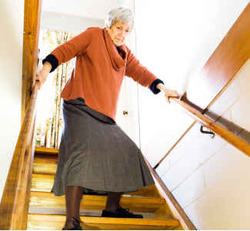Falls can occur for various reasons. The following list are just a few of the major types of different falls that you or your loved one can experience.
- Accidental falls
- Unanticipated physiologic falls occur when the physical cause of the falls is not reflected in the patient’s risk factor for falls.
- Anticipated physiologic falls occur in patients whose score on risk assessment scales
It is generally accepted that patient falls are caused by multiple factors. Another popular classification scheme of falls is based on the assumption that they result from a complex interaction of intrinsic and/or extrinsic risk factors as illustrated in the figure below. The summary list that follows is derived from many studies incorporating different methodologies, settings, samples and overall quality. Individual risk factors may not be generalized across all settings and may not be applicable to a particular organization.
Intrinsic risk factors
(i.e., integral to the patient’s system, many of which are associated with age-related changes):
- Previous fall – studies have cited a history of falls as a significant factor associated with patients being more likely to fall again.
- Reduced vision – vision affected by, for example, a decline in visual acuity, decreased night vision, altered depth perception, decline in peripheral vision, or glare intolerance.
- Unsteady gait – manner and style of walking.
- Musculoskeletal system – impact from factors such as muscle atrophy, calcification of tendons and ligaments, and increased curvature of the spine (osteoporosis) are associated with ability to maintain balance and proper posture.
- Mental status – status affected by confusion, disorientation, inability to understand, and impaired memory.
- Acute illnesses – rapid onset of symptoms associated with seizures, stroke, orthostatic hypotension, and febrile conditions.
- Chronic illnesses – conditions such as arthritis, cataracts, glaucoma, dementia, diabetes and Parkinsonism.
Extrinsic risk factors
(i.e., external to the system and relating to the physical environment):
- Medications – those that affect the central nervous system, such as sedatives and tranquilizers, benzodiazepines, and the number of administered drugs.
- Bathtubs and toilets – equipment without support, such as grab bars.
- Design of furnishings – height of chairs and beds.
- Condition of ground surfaces – floor coverings with loose or thick-pile carpeting, sliding rugs, upended linoleum or tile flooring, highly polished or wet ground surfaces.
- Poor illumination conditions – intensity or glare issues.
- Type and condition of footwear – ill-fitting shoes or incompatible soles such as rubber crepe soles, which, though slip resistant, may stick to linoleum floor surfaces.
- Improper use of devices – bedside rails and mechanical restraining devices that may actually increase fall risk in some instances.
- Inadequate assistive devices – walkers, wheelchairs and lifting devices.

